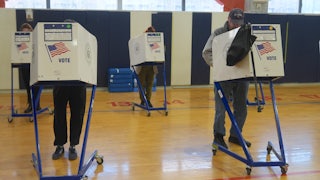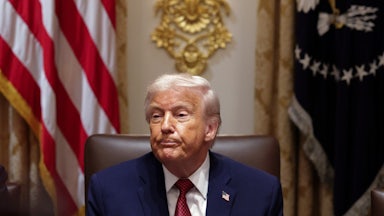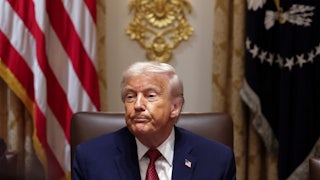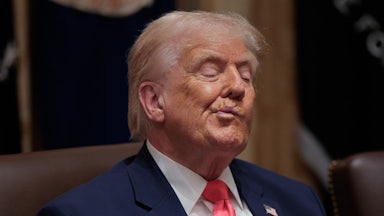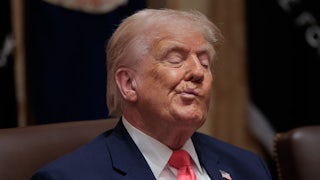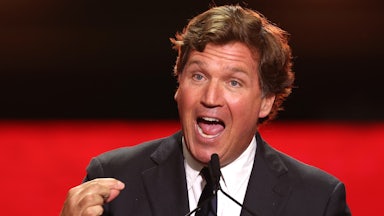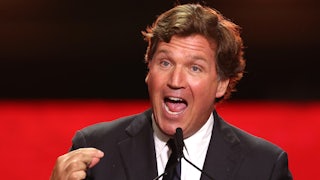The protest of the protests has begun.
Despite overwhelming evidence that the demonstrations in Los Angeles are largely peaceful, we’re nonetheless hearing the paternalistic refrain that protesters should “obey the law”—as if they’re feral children in need of reminders about the norms of civic society. The sages of the punditocracy have rather predictably conflated mass anger with mass mayhem, even suggesting that the best strategy is simply to go home and hope for the best.
“As unsatisfying as it may be for some citizens to hear, the last thing anyone should do is take to the streets of Los Angeles and try to confront the military or any of California’s law-enforcement authorities,” Tom Nichols pleaded in The Atlantic on Sunday. Fearing Trump is searching for a “pretext” to use force (as if Trump requires a pretext), he cautioned the protesters: “Be warned: Trump is expecting resistance. You will not be heroes. You will be the pretext.”
Yes, please don’t resist. By all means, take to the streets—but do so in a perfectly orderly, law-abiding way. If you encounter the military, National Guard, or law enforcement, tuck tail and run. Better yet, sit quietly in your living room and watch it all play out on TV. Because otherwise you risk giving Trump a pretext to crack down even harder on undocumented immigrants, to militarize entire cities, and even to take control of elections.
This line of reasoning, which can be readily found among the center-left and center-right commentariat, makes a number of fatal mistakes. We all know (or should know by now) that Trump doesn’t actually need a pretext to do whatever he wants to do. And for many Angelenos, whatever Trump attempts to do next is hardly front of mind; as far as they’re concerned, the worst-case scenario is happening to them right now. ICE is snatching up family members, neighbors, friends, and co-workers at their workplaces. The terror has already reached their doorstep, even if it has not yet reached the pundits’.
Nichols suggested that the greatest victory for Trump’s opponents would be for government forces to arrive with rifles in tow and find the streets empty, so that they would wonder why the president had sent them there. “This kind of restraint will deny Trump the political oxygen he’s trying to generate,” Nichols argued. The logic is confounding, to say the least: If only the protesters completely capitulate, then Trump will be humbled. It will appear as though there was civil unrest and violence before he sent in the military, and then peace in the immediate aftermath of him doing so, but somehow this will make Trump weaker?
Nichols’s Atlantic colleague David Frum seemed largely in concurrence, arguing that Trump’s actions in L.A. constitute, per the essay’s headline, a “dress rehearsal” for future deployments, when the president might use the military to challenge elections. Any perception of widespread disorder, Frum argued, could serve Trump’s purposes. “If Trump can incite disturbances in blue states before the midterm elections,” Frum contended, “he can assert emergency powers to impose federal control over the voting process, which is to say his control.” The problem, though, is that Trump is already doing this: He issued an executive order in March outlining such a plan and providing justification for the trimming of voter rolls. If we don’t show that we’re willing to fight back, peacefully but forcefully, there may be no midterm—at least not a wholly legitimate one.
The pleas for protesters to be law-abiding—which have come not just from pundits, of course, but many elected Democrats too—may seem noncontroversial, but it’s the kind of preaching that inadvertently advances Trump’s narrative about chaos in the cities of Democratic-run states. It implicitly accepts the prevailing media narrative of violence and destruction, even though only a tiny fraction of protests, largely in one small pocket of Los Angeles, are responsible for the images being shown 24/7 on cable news.
It’s also a bit ironic given Trump’s very own lawlessness. He’s constantly pardoning MAGA members who’ve committed serious offenses, including the January 6 attackers; has suffered no true legal consequences for his own lawlessness; is, by any reasonable measure, the most corrupt president in history; and recently called on border czar Tom Homan to arrest California Governor Gavin Newsom for allegedly obstructing federal immigration enforcement. Trump’s very sending in of the National Guard and Marines—now totaling 4,700 soldiers—likely violates the Posse Comitatus Act of 1878, which prohibits using the military for general policing purposes. Trump could invoke the Insurrection Act, as he’s threatened to do in the past, but he’s forgotten about that one so far. (It would be outlandish to argue that the protests constitute an insurrection, but the letter of the law has never concerned him.)
This is not to excuse any violence on the part of protesters. Yes, there have been arrests for violence, including some serious ones, like a man arrested for attempted murder. But out of 114 people arrested on Monday night, 53 had committed the “crime” of failure to disperse. In other words, they were arrested for protesting out of designated protest zones—zones often used to make sure protesters are little seen and less heard. As the protest continues, you can be sure that more arrests will be of this nature, especially now that Mayor Karen Bass has instituted an 8 p.m. curfew.
Yet, while we definitely want to avoid violence, we should not want to avoid tension. In fact, we want the “creative tension” that MLK called for in his Letter From a Birmingham Jail—a form of direct action that brings injustices to the surface. There’s a history of this: the Boston Tea Party, the Selma march, the AIDS die-ins, the lunch counter sit-ins—all were deemed illegal, as were various Vietnam protests. The Kent State and Attica tragedies, meanwhile, both occurred after the National Guard was called in—legally—supposedly to keep order.
Requiring protests to be perfectly lawful is a way of precluding all protests. It makes every protester responsible for every other protester, and justifies the use of restrictions like delineated protest zones, orders for dispersal, and the curfew Bass has now instituted. People who set cars on fire or throw rocks at police should be arrested, but they shouldn’t be used to mischaracterize protests that are the result of justifiable anger at Trump administration policies that have destroyed families and communities. Likewise, while safeguarding property and people’s businesses should be important, safeguarding the right to protest should be considered absolutely essential, since without free speech there is no democracy.
Measures taken to curtail that right should only be instituted with great diligence and only in circumstances where a clear and extraordinary danger to the public requires it. That’s not what we’re witnessing here; the federal government isn’t stopping the danger, it’s creating it. It is Trump who is causing the conflagration through his instigation and escalation, which was surely the goal the entire time (predictably, top Trump aide Stephen Miller was the architect of the ICE crackdown in Los Angeles). The monster isn’t attacking from outside; it’s in the house. And that house is the White House.
Newsom, hopefully done playing footsie with bigoted Trump acolytes like Charlie Kirk and recovering his backbone somewhat, has acknowledged this fact. On Tuesday, he accused Trump of putting everyone in danger by inflaming an already combustible situation. He called it a “perilous moment,” wherein “a president who wants to be bound by no law or Constitution [is] perpetuating a unified assault on American tradition.” With watery, intense eyes, he added, “California may be first, but it clearly will not end here. Other states are next. Democracy is next. Democracy is under assault before our eyes.”
Now’s the time to stand up and fight. Otherwise, we’ll watch democracy die on the operating table in front of us. A plurality of Americans oppose Trump’s military campaign in L.A.; their numbers will likely grow if he escalates it and expands it to other cities where protests are spreading. But if protesters were to stand down, out of fear that any potential conflict with law enforcement empowers Trump, then that would make an inept buffoon of a leader appear to be strong.
Some pundits may prefer that we all just sit home and hope the whole Trump problem goes away. But I prefer the doctrine of the famed AIDS activist and gay rights leader Larry Kramer, who said simply, “Shove it in their faces.”

